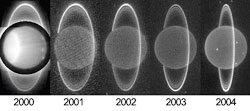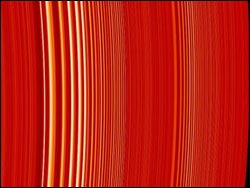This area deals with the fundamental laws and building blocks of nature and how they interact, the properties and the behavior of matter, and research into space and time and their structures.
innovations-report provides in-depth reports and articles on subjects such as astrophysics, laser technologies, nuclear, quantum, particle and solid-state physics, nanotechnologies, planetary research and findings (Mars, Venus) and developments related to the Hubble Telescope.

As summer draws to a close in the southern hemisphere of Uranus, storm clouds are brewing in the upper atmosphere, northern hemisphere winds are gusting to 250 miles per hour, and the planet’s rings are getting brighter every day.
This weather report comes from researchers using the Keck II 10-meter telescope atop Mauna Kea volcano in Hawaii, where recent observations are proving that Uranus is not the “boring and unchanging” planet people have assumed, according to Imke de

Researchers at the National Institute of Standards and Technology (NIST) have demonstrated a technique for growing well-formed, single-crystal nanowires in place—and in a predictable orientation—on a commercially important substrate.
The method uses nanoparticles of gold arranged in rows on a sapphire surface as starting points for growing horizontal semiconductor “wires” only 3 nanometers (nm) in diameter. Other methods produce semiconductor nanowires more than 10 nm in dia

A laser-based method for identifying a single atom or molecule hidden among 10 trillion others soon may find its way from the laboratory to the real world.
Developed by physicists at the National Institute of Standards and Technology (NIST), the technique is believed to be more than 1,000 times more sensitive than conventional methods. Vescent Photonics of Denver, Colo., hopes to commercialize the method as an “optical nose” for atmospheric monitoring. The portable sensors would r

Peering into the center of Sandia National Laboratory’s Z machine as it fires had been a feat unachievable for a decade.
Other than a nuclear bomb, Z is the most powerful generator of X-rays on the planet. Last year, its central mechanism, called a Z-pinch, fused isotopes of hydrogen to create nuclear fusion. Now, by inserting a pretty, two-inch-long crystal that reflects at only a single frequency into the hellish center of Z as it fires, researchers have been able to visuall

This false-colour image of two density waves in Saturn’s A ring was taken by the NASA/ESA/ASI Cassini-Huygens spacecraft at a distance of 6.8 million kilometres from Saturn.
The image was made from the stellar occultation observed by the Cassini-Huygens Ultraviolet Imaging Spectrograph, and shows a section of rings about 724 kilometres across and the smallest features about half a kilometre across.
Bright areas indicate the denser regions of the rings. The bright ban

These images, taken by the High Resolution Stereo Camera (HRSC) on board ESA’s Mars Express spacecraft, are Europe’s highest-resolution pictures so far of the Martian moon Phobos.
These HRSC images show new detail that will keep planetary scientists busy for years, working to unravel the mysteries of this moon. The images show the Mars-facing side of the moon, taken from a distance of less than 200 kilometres with a resolution of about seven metres per pixel during orbit 756.